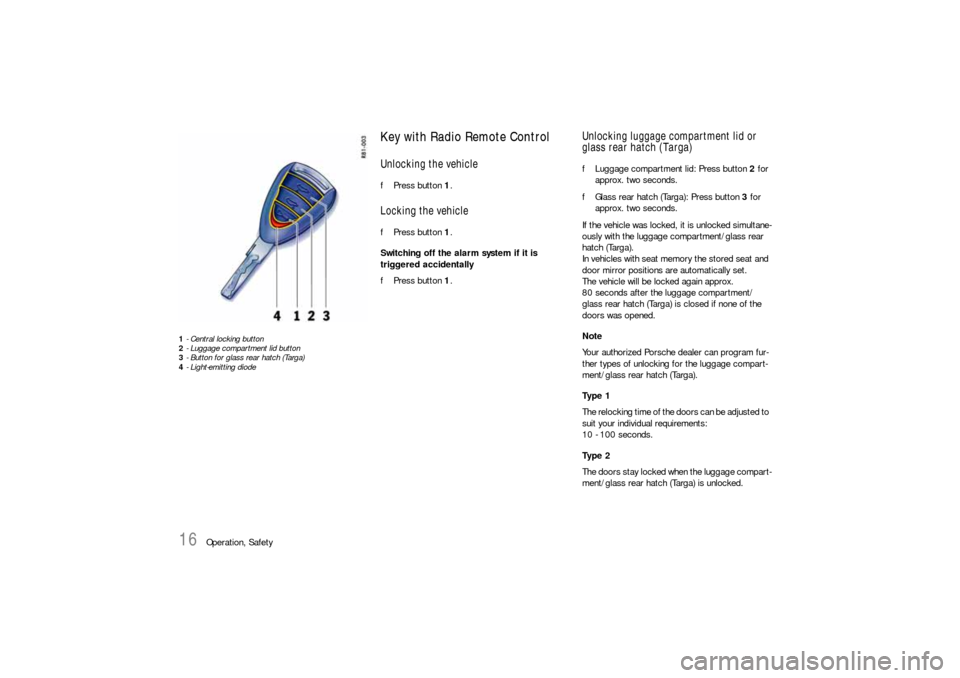PORSCHE 911 2009 5.G User Guide
Manufacturer: PORSCHE, Model Year: 2009, Model line: 911, Model: PORSCHE 911 2009 5.GPages: 310, PDF Size: 3.39 MB
Page 11 of 310

Before driving off...
9
In the driver’s seat... fCheck operation of the horn.
fPosition seat for easy reach of foot pedals and
controls.
To reduce the possibility of injury from the
airbag deployment, you should always sit back
as far from the steering wheel as is practical,
while still maintaining full vehicle control.
fAdjust the inside and outside rear view mirrors.
fBuckle your safety belts.
fCheck operation of the foot and parking brake.
fCheck all warning and indicator lights with
ignition on and engine not running.
fStart engine and check all warning displays for
warning symbols.
fNever leave an idling car unattended.
fLock doors from inside, especially with chil-
dren in the car to prevent inadvertent opening
of doors from inside or outside.
Drive with doors locked.
On the road... fNever drive after you have consumed alcohol
or drugs.
fAlways have your safety belt fastened.
fAlways drive defensively.
Expect the unexpected.
fUse signals to indicate turns and lane changes.
fTurn on headlights at dusk or when the driving
conditions warrant it.
fAlways keep a safe distance from the vehicle in
front of you, depending on traffic, road and
weather conditions.
fReduce speed at night and during inclement
weather.
Driving in wet weather requires caution and re-
duced speeds, particularly on roads with
standing water, as the handling characteristics
of the vehicle may be impaired due to hydro-
planing of the tires.
fAlways observe speed limits and obey road
signs and traffic laws.
fWhen tired, get well off the road, stop and take
a rest. Turn the engine off. Do not sit in the ve-
hicle with engine idling.
Please see the chapter “ENGINE EXHAUST” on
Page 5.fWhen parked, always set the parking brake.
Move the PDK selector lever to ”P“ or the gear-
shift lever to reverse or first gear.
On hills also turn the front wheels toward the
curb.
fWhen emergency repairs become necessary,
move the vehicle well off the road. Turn on the
emergency flasher and use other warning de-
vices to alert other motorists. Do not park or
operate the vehicle in areas where the hot ex-
haust system may come in contact with dry
grass, brush, fuel spill or other flammable ma-
terial.
fMake it a habit to have the engine oil checked
with every refueling.
Page 12 of 310

10
Before driving off...
Break in hints for the first
2,000 miles/3,000 kilometers The following tips will be helpful in obtaining opti-
mum performance from your new Porsche.
Despite the most modern, high-precision manufac-
turing methods, the moving parts must still wear
in with each other. This wearing-in occurs mainly in
the first 2,000 miles/3,000 kilometers.Therefore: fPreferably take longer trips.
fAvoid frequent cold starts with short-distance
driving whenever possible.
fAvoid full throttle starts and abrupt stops.
fDo not exceed maximum engine speed of
4,200 rpm (revolutions per minute).
fDo not run a cold engine at high rpm either in
Neutral or in gear.
fDo not let the engine labor, especially when
driving uphill. Shift to the next lower gear in
time (use the most favorable rpm range).
fNever lug the engine in high gear at low
speeds. This rule applies at all times, not just
during the break-in period.fDo not participate in motor racing events,
sports driving schools, etc. during the first
2,000 miles/3,000 kilometers.
There may be a slight stiffness in the steering,
gear-shifting or other controls during the break-in
period which will gradually disappear.
Break in brake pads and brake discsNew brake pads and discs have to be “broken in”,
and therefore only attain optimal friction when the
car has covered several hundred miles or km.
The slightly reduced braking ability must be com-
pensated for by pressing the brake pedal harder.
This also applies whenever the brake pads and
brake discs are replaced. New tires New tires do not have maximum traction. They
tend to be slippery.
fBreak in new tires by driving at moderate
speeds during the first 60 to 120 miles/100 to
200 km. Longer braking distances must be an-
ticipated.
Engine oil and fuel consumption During the break-in period oil and fuel consump-
tion may be higher than normal.
As always, the rate of oil consumption depends on
the quality and viscosity of oil, the speed at which
the engine is operated, the climate and road con-
ditions, as well as the amount of dilution and oxi-
dation of the lubricant.
fMake a habit of checking engine oil with every
refueling, add if necessary.
Page 13 of 310

Before driving off...
11
1 Inner door handle, Page 18
2 Power windows, Page 25
3 Door mirror control, Page 27
4 Hands-free microphone
5 Diagnostic socket (OBD)
6 Front and rear lid release, Page 93
7 Steering-wheel adjustment, Page 37
8 Seat height adjustment, Page 30
9 Backrest angle adjustment, Page 30
10 Seat fore-and-aft adjustment, Page 30
Page 14 of 310

12
Before driving off...1 Light switch, Page 80
2 Ignition/starter switch, Page 74
3 Turn signal/headlight dimmer,
flasher lever, Page 82
4 Operating lever for on-board computer,
Page 128
5Horn
6 Operating lever for automatic speed control,
Page 86
7 Wiper/washer lever, rear window wiper,
Page 83
8 Stopwatch, Page 138
9 Interior temperature sensor
10 Emergency flasher switch, Page 79
11 Central locking button, readiness display for
alarm system, Page 19
12 Cupholder, Page 88
13 Seat heating/Seat ventilation left/right,
Page 35
14 Operating panel for air conditioning, Page 108
15 Sport/Sport Plus program, Page 64
Rear spoiler, Page 69
Porsche Active Suspension Management
(PASM), Page 69
Porsche Stability Management
(PSM), Page 66
Sports exhaust system, Page 57
Page 15 of 310

Operation, Safety
13 Operation, Safety
Keys ........................................................... 15
Security Wheel Bolts.................................... 15
Doors ......................................................... 18
Central Locking ........................................... 19
Alarm System,
Passenger Compartment Monitoring ............. 23
Power Windows ........................................... 25
Mirrors ........................................................ 27
Rear Window Defogger, Door Mirror Heating .. 29
Seat Adjustment and Head Restraints ............ 30
Seat Memory ............................................... 33
Heated Seats .............................................. 35
Seat Ventilation ............................................ 36
Rear Seat Backrests.................................... 37
Steering Wheel Adjustment ........................... 37
Steering Wheel Heating ................................ 38
Multi-Functional Steering Wheel ..................... 39
Sun Visors................................................... 40
Safety Belts................................................. 41
Airbag Systems ........................................... 44
Child Restraint Systems................................ 50
LATCH System
Child seat bracket on the passenger’s seat .... 54
Child Restraint Anchorages ........................... 55
Rollover Protection System ........................... 56
Sports Exhaust System................................ 57
Parking Brake .............................................. 57
Brakes ........................................................ 58
ABS Brake System (Antilock Brake System) ... 61
Clutch Pedal ................................................ 62
Porsche Traction Management (PTM)............. 63
Sport Mode ................................................. 64Porsche Stability Management (PSM)............. 66
Porsche Active Suspension Management
(PASM) ........................................................ 69
Retractable Rear Spoiler............................... 69
Interior Lights .............................................. 71
Parking Aids ................................................ 72
Ignition/Starter Switch with
anti-theft Steering Lock ................................ 74
Starting Procedures ..................................... 77
Stopping Engine .......................................... 78
Emergency Flasher Switch ............................ 79
Light Switch ................................................ 80
Welcome Home Lighting............................... 81
Automatic Headlight Beam Adjustment .......... 81
Turn Signal / Headlight Dimmer /
Parking light / Flasher Lever ......................... 82
Windshield Wiper / Washer Lever .................. 83
Automatic Speed Control.............................. 86
Cupholder ................................................... 88
Ashtray ....................................................... 89
Cigarette Lighter .......................................... 90
Storage in the Passenger Compartment ........ 91
Luggage Compartment Lid and
Engine Compartment Lid .............................. 93
Luggage Compartment (Vehicles without
Porsche Traction Management PTM).............. 95
Luggage Compartment (Vehicles with
Porsche Traction Management PTM).............. 96
Trunk Entrapment ........................................ 97
Porsche Communication Management (PCM).. 98
Car Telephone and Aftermarket Alarms ........ 100
iPod, USB and AUX .................................... 101Fire Extinguisher ........................................ 102
HomeLink .................................................. 103
Page 16 of 310

14
Operation, Safety
Never invite car theft! An unlocked car with the key in the ignition lock
invites car theft.
A steering wheel lock and a gong alarm are
standard equipment in your Porsche.
The gong alarm will sound if you open the driver’s
door while the key is still in the ignition lock. It is
your reminder to pull the key out of the ignition
lock and to lock the doors.
Warning!
Any uncontrolled movement of the vehicle
may result in property damage, serious per-
sonal injury or death.
Never leave your vehicle unattended with the
key in the ignition lock, especially if children
and/or pets are left unattended in the vehi-
cle. They can operate power windows and
other controls. If the engine is left running,
they may accidentally engage the shift lever.
Serious personal injury or death could result
from loss of control of the vehicle.
fAlways remove the ignition key.
fAlways set the parking brake.
fLock the doors with the remote control.
Warning!
Risk of a serious accident.
The steering column will lock when you re-
move the key while you are driving or as the
car is rolling to a stop. You will not be able to
steer the car.
Serious personal injury or death could result
from loss of control of the vehicle.
fNever remove the key from the steering lock while you are driving. To protect your vehicle and your possessions
from theft, you should always proceed as
follows when leaving your vehicle:
fClose windows.
fClose lifting/sliding roof
fClose convertible top (with the convertible top
open, the passenger compartment monitoring
system is always switched off)
fClose the sliding glass roof (Targa) (with the
sliding glass roof open, the passenger com-
partment monitoring system is always
switched off)
fRemove ignition key.
fEngage steering lock.
fLock glove compartment.
fRemove valuables (e.g. car documents, tele-
phone, house keys) from the car.
fLock doors.
Page 17 of 310

Operation, Safety
15
Keys fPlease see the chapter “ALARM SYSTEM, PAS-
SENGER COMPARTMENT MONITORING” on
Page 23.
fPlease see the chapter “CENTRAL LOCKING”
on Page 19.
Two car keys are supplied with your Porsche.
These keys operate all the locks on your vehicle.
fBe careful with your car keys: do not part with
them except under exceptional circumstances.
fTo avoid battery run-down, always remove the
ignition key from the ignition lock.
Replacement keys Replacement car keys can be obtained only from
your authorized Porsche dealer, and this can
sometimes be very time-consuming.
You should therefore always keep a spare key on
your person.
Keep it in a safe place (e.g. wallet), but under no
circumstances in or on the vehicle.
The key codes of new keys have to be “reported”
to the car control unit by your authorized Porsche
dealer.
A total of 6 car keys can be reported to the control
unit.
Disabling key codes
If a key is lost, the key codes can be disabled by
an authorized Porsche dealer.
All the remaining car keys are required for this pur-
pose.
Disabling the code ensures that the car can be
started only using authorized keys.
Note
fPlease note that the other locks can still be
opened with the disabled key.
Immobilizer There is a transponder (an electronic component)
in the key grip, containing a stored code.
When the ignition is switched on, the ignition lock
checks the code.
The immobilizer can be deactivated and the en-
gine started only using an authorized ignition key.
Switching off the immobilizer
fInsert the ignition key into the ignition lock.
If the ignition is left on for more than 2 minutes
without the engine being started, the immobilizer
is switched on again.
fIf this happens, turn the ignition key back to
position 3 (ignition off) before starting the
engine. The immobilizer is switched off again,
and the engine can be started.
fPlease see the chapter “IGNITION/STARTER
SWITCH WITH ANTI-THEFT STEERING LOCK”
on Page 74.
Switching on the immobilizer
fRemove ignition key.Security Wheel Bolts fIf wheels have to be removed during a work-
shop visit, do not forget to hand over the sock-
et for the security wheel bolts along with the
car key.
Page 18 of 310

16
Operation, Safety
1- Central locking button
2- Luggage compartment lid button
3- Button for glass rear hatch (Targa)
4- Light-emitting diode
Key with Radio Remote Control Unlocking the vehiclefPress button 1.Locking the vehiclefPress button 1.
Switching off the alarm system if it is
triggered accidentally
fPress button 1.
Unlocking luggage compartment lid or
glass rear hatch (Targa)fLuggage compartment lid: Press button 2 for
approx. two seconds.
fGlass rear hatch (Targa): Press button 3 for
approx. two seconds.
If the vehicle was locked, it is unlocked simultane-
ously with the luggage compartment/glass rear
hatch (Targa).
In vehicles with seat memory the stored seat and
door mirror positions are automatically set.
The vehicle will be locked again approx.
80 seconds after the luggage compartment/
glass rear hatch (Targa) is closed if none of the
doors was opened.
Note
Your authorized Porsche dealer can program fur-
ther types of unlocking for the luggage compart-
ment/glass rear hatch (Targa).
Ty p e 1
The relocking time of the doors can be adjusted to
suit your individual requirements:
10 - 100 seconds.
Ty p e 2
The doors stay locked when the luggage compart-
ment/glass rear hatch (Targa) is unlocked.
Page 19 of 310

Operation, Safety
17
The remote-control standby function
switches off after 7 daysIf the vehicle is not started or unlocked with the re-
mote control within 7 days, the remote control
standby function is switched off (to prevent dis-
charging of the vehicle battery).
1. In this case, unlock the driver’s door with the
key at the door lock.
Leave the door closed in order to prevent the
alarm system from being triggered.
2. Press button 1 on the remote control.
The remote control is now activated again and
the alarm system is switched off.
Operational readiness of the remote
control interruptedEncoded data is transmitted to the vehicle each
time the wireless remote control is operated. If the
remote control is operated too often outside the
range of the vehicle, this can result in the central
locking system no longer responding.
In this case, the remote control and vehicle must
be synchronized.
Carrying out the synchronization
1. Unlock the driver's door with the key at the
door lock.
2. Open driver’s door and insert the ignition key
into the ignition lock within 10 seconds to
prevent the alarm system from being
triggered.
3. With the key inserted, press and hold button 1
on the remote control for approx. 5 seconds.
The synchronization is now complete.
Page 20 of 310

18
Operation, Safety
DoorsIf the door windows are closed, they will be auto-
matically opened by a few millimeters when the
doors are opened and, when the doors are closed,
they will be closed again. This makes it easier to
open and close the doors and protects the seals.
fTherefore, you should pull the door handle
slowly so that the door window can be lowered
before the door is opened.Opening doors from outside fUnlock vehicle with the remote control.
fSlowly pull door handle A.
Opening unlocked doors from inside fSlowly pull door handle B. Opening locked doors from inside fSlowly pull door handle B twice.
fPlease see the chapter “LOCKING CONDITI-
ONS” on Page 20.
Door storage trayOpening storage tray
fOpen the cover C.
Keep the door storage tray C closed while driving
for safety reasons.